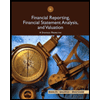
LOOSE-LEAF Advanced Financial Accounting with Connect
11th Edition
ISBN: 9781259605192
Author: Theodore E. Christensen
Publisher: McGraw-Hill Education
expand_more
expand_more
format_list_bulleted
Concept explainers
Question
Chapter 4, Problem 4.18.2E
To determine
Introduction: Consolidation is a process in which a parent company combines net assets of its subsidiaries. To include net assets of the subsidiaries, parent company removes net assets in those subsidiaries and removes intragroup transactions.
To compute: Amount to be shown in the consolidated
Expert Solution & Answer
Want to see the full answer?
Check out a sample textbook solution
Students have asked these similar questions
Computer Zone sells laptops. During August 2023, it sold 320 laptops at a $1,850 average price each. The August 2023 budget included sales of 350 laptops at an average price of $1,750 each. Compute the sales price variance and the sales volume variance for August 2023.
Please provide the answer to this general accounting question using the right approach.
Calculate the labor variance.
Chapter 4 Solutions
LOOSE-LEAF Advanced Financial Accounting with Connect
Ch. 4 - When is the carrying value of the investment...Ch. 4 - What is a differential? How is a differential...Ch. 4 - Prob. 4.3QCh. 4 - Prob. 4.4QCh. 4 - Prob. 4.5QCh. 4 - Prob. 4.6QCh. 4 - Prob. 4.7QCh. 4 - Prob. 4.8QCh. 4 - Prob. 4.9QCh. 4 - Prob. 4.10Q
Ch. 4 - Prob. 4.11QCh. 4 - What determines whether the balance assigned to...Ch. 4 - What does the termpushdown accountingmean?Ch. 4 - Under what conditions is push-down accounting...Ch. 4 - Prob. 4.15QCh. 4 - Reporting Significant Investments in Common Stock...Ch. 4 - Prob. 4.2CCh. 4 - Prob. 4.3CCh. 4 - Prob. 4.4CCh. 4 - Prob. 4.5CCh. 4 - Prob. 4.1ECh. 4 - Prob. 4.2ECh. 4 - Prob. 4.3ECh. 4 - Prob. 4.4ECh. 4 - Prob. 4.5ECh. 4 - Prob. 4.6ECh. 4 - Prob. 4.7ECh. 4 - Prob. 4.8ECh. 4 - Prob. 4.9ECh. 4 - Prob. 4.10.1ECh. 4 - Prob. 4.10.2ECh. 4 - Prob. 4.10.3ECh. 4 - Prob. 4.10.4ECh. 4 - Prob. 4.10.5ECh. 4 - Prob. 4.11.1ECh. 4 - Prob. 4.11.2ECh. 4 - Prob. 4.11.3ECh. 4 - Prob. 4.11.4ECh. 4 - Prob. 4.12ECh. 4 - Prob. 4.13ECh. 4 - Prob. 4.14ECh. 4 - Prob. 4.15ECh. 4 - Prob. 4.16ECh. 4 - Prob. 4.17ECh. 4 - Prob. 4.18.1ECh. 4 - Prob. 4.18.2ECh. 4 - Prob. 4.18.3ECh. 4 - Prob. 4.18.4ECh. 4 - Prob. 4.18.5ECh. 4 - Prob. 4.18.6ECh. 4 - Prob. 4.19ECh. 4 - Prob. 4.30PCh. 4 - Prob. 4.33PCh. 4 - Prob. 4.35PCh. 4 - Prob. 4.36PCh. 4 - Prob. 4.37AP
Knowledge Booster
Learn more about
Need a deep-dive on the concept behind this application? Look no further. Learn more about this topic, accounting and related others by exploring similar questions and additional content below.Similar questions
- Horngren's Financial & Managerial Accounting: The Managerial Chapters, 8th Edition E-M:8-18 Defining the benefits of setting cost standards and calculating materials and labor variancesColton, Inc. produced 1,000 units of the company’s product in 2025. The standard quantity allowed of direct materials was three yards of cloth per unit at a standard cost of $1.05 per yard. The accounting records showed that 2,600 yards of cloth were used and the company paid $1.10 per yard. Standard time was two direct labor hours per unit at a standard rate of $16.00 per direct labor hour. Employees worked 1,400 hours and were paid $15.50 per hour. Requirements1.What are the benefits of setting cost standards? 2. Calculate the direct materials cost variance and the direct materials efficiency variance as well as the direct labor cost and efficiency variances. 2. DM Eff. Var. $420 Farrow_forwardFrom Horngren's Financial & Managerial Accounting: The Managerial Chapters, 8th Edition E-M:8-16 Preparing a flexible budget performance report. Complete the performance report. ARVIN COMPANY Flexible Budget Performance Report For the Year Ended July 31, 2025 Actual Results Flexible Budget Var Flexible Budget Sales Vol Variance Static Budget Units 39,000 a 39,000 3,000 g Sales Revenue $ 218,000 b $ 218,000 $ 27,000 h Variable Expenses 84,000 c 81,000 10,000 i Contribution Margin $ 134,000 d $ 137,000 $ 17,000 j Fixed Expenses 108,000 e 101,000 - k Operating Income $ 26,000 f $ 36,000 $ 17,000 l…arrow_forwardI need help answering the following question below for my class discussion. After taking Managerial Accounting, you like the discipline and the potential it presents for your future career advancement, so you take the Certified Management Accountant exam and pass it with flying colors. To get my career going, I am considering starting a consulting business, advising other enterprises on managerial accounting related issues (internal controls, how to organize the responsibility centers and how to evaluate them, automate their system to track managerial data including production costs, how to set up the budgeting system and how to control costs, etc.). To organize my consulting business, I need to look up on the form of business to organize my consulting firm under. Specifically, I want to consider the form of business from the perspectives of liability (including mutual agency), taxes, control. Which form of business should I choose? justifing my choice and being creative with my…arrow_forward
- Nonearrow_forwardhttps://investor.exxonmobil.com/sec-filings/annual-reports/content/0000034088-25-000010/0000034088-25-000010.pdf Use link to help me answer my questions please in picturearrow_forwardPlease provide the accurate answer to this general accounting problem using appropriate methods.arrow_forward
- Can you explain the correct approach to solve this general accounting question?arrow_forwardPlease help me solve this general accounting problem with the correct financial process.arrow_forwardI am trying to find the accurate solution to this general accounting problem with appropriate explanations.arrow_forward
arrow_back_ios
SEE MORE QUESTIONS
arrow_forward_ios
Recommended textbooks for you
 Financial Reporting, Financial Statement Analysis...FinanceISBN:9781285190907Author:James M. Wahlen, Stephen P. Baginski, Mark BradshawPublisher:Cengage Learning
Financial Reporting, Financial Statement Analysis...FinanceISBN:9781285190907Author:James M. Wahlen, Stephen P. Baginski, Mark BradshawPublisher:Cengage Learning

Financial Reporting, Financial Statement Analysis...
Finance
ISBN:9781285190907
Author:James M. Wahlen, Stephen P. Baginski, Mark Bradshaw
Publisher:Cengage Learning